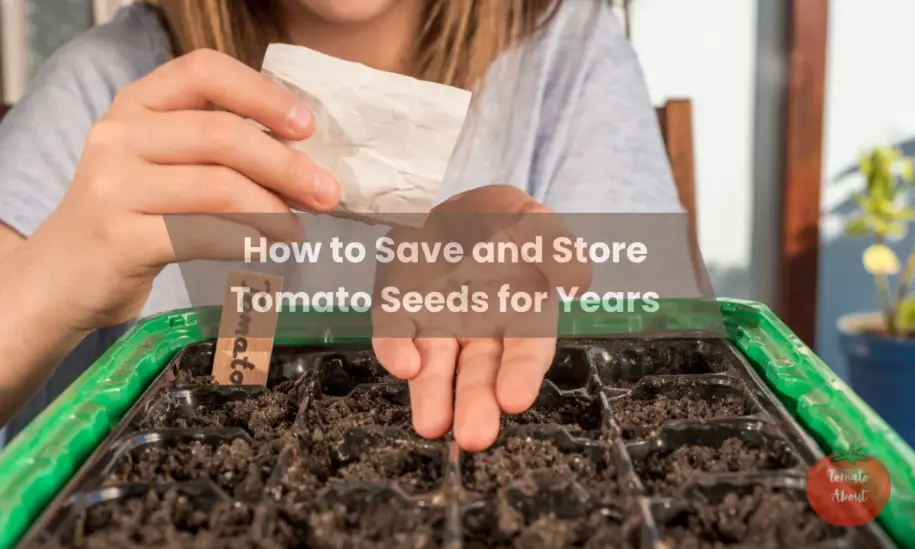Tomatoes are one of the most popular vegetables to grow in home gardens. And for good reason – their versatility, flavors, and nutrients make them an essential part of many summer meals.
But did you know that with a little knowledge and patience, you can save seeds from your healthiest, tastiest tomatoes to plant again next year?
Saving tomato seeds is easy, and free, and ensures you’ll have an ongoing supply of your favorite tomato varieties. In this complete guide, I’ll walk through the simple steps for saving and storing tomato seeds.
Why Save Tomato Seeds?
Here are some of the best reasons to save seeds from your homegrown tomatoes:
- It’s free! Purchasing seeds can add up over the years. Saving your own tomato seeds provides an endless supply at no cost.
- Maintain heirloom varieties. Many beloved heirloom tomatoes are passed down through saved seeds. This helps preserve genetic diversity in our food supply.
- Regional adaptation. Tomatoes grown in your area will develop traits adapted to your local climate and soil. Saving seeds maintains locally adapted plants.
- Continue growing favorites. Found the perfect slicing tomato or a cherry tomato your kids love? Saving seeds allows you to keep growing those winning varieties.
- Seed longevity. Properly stored tomato seeds remain viable for 4 years or longer. This gives you a supply of seeds for several seasons.
- Satisfaction. Taking part in the ancient practice of seed saving is rewarding and fulfilling. Plus, it’s as simple as can be!
Tips for Success
Follow these best practices when saving and storing tomato seeds:
- Allow tomatoes to fully ripen on the vine before collecting seeds. Unripe tomatoes yield seeds with poor viability. I recommend waiting until tomatoes are soft to the touch.
- Ferment seeds in water for 2-4 days to clean gel sacs off seeds before drying. This optional step improves storage.
- Dry seeds thoroughly before storage to prevent mold issues. Proper drying is critical.
- Store seeds in envelopes in a cool, dark place like the fridge. Envelopes allow continued drying while minimizing temperature fluctuations.
- Use seeds within 1-5 years for best germination rates. Stored properly, tomato seeds remain viable for many seasons.
How to save Tomato seeds?
Now let’s uncover the easy process so you can start saving your own tomato seeds!
Step 1 – Choose Fully Ripe Tomatoes
The first step is choosing appropriate fruits from which to save tomato seeds.
Only collect seeds from fully ripe tomatoes. Green or partially ripe tomatoes will produce seeds that are not adequately matured and have poor germination rates.
I recommend waiting until tomatoes are fully red, soft to the touch, and naturally fall off the vine with little resistance. These traits indicate optimal ripeness.
In addition, select the biggest, healthiest looking tomatoes from your healthiest plants. This helps promote strong genetics in saved seeds, improving vitality in future generations.
If growing multiple varieties, pay close attention to correctly identify each tomato plant to avoid hybridization. Consider labeling plants if you grow many types.
Step 2 – Remove Gel and Pulp
Once harvested, the process of removing seeds begins.
Cut several ripe tomatoes in half crosswise. Then, gently squeeze each half over a jar or bowl to remove pulp and seeds.
Avoid using metal bowls as the acids in tomato juice can react with metals. Glass, ceramic or plastic containers are best.
Scoop out any remaining gel and seed clusters using a spoon or your fingers. Don’t worry about separating the seeds from gel just yet – this will happen during fermentation.
Repeat this process until the jar contains seeds from several tomatoes. More tomatoes means more seeds to save!
I like to work over a large cutting board outdoors. Tomato guts can be messy, so newspaper or paper towels also help with easy cleanup.
Step 3 – Ferment Seeds in Water (Optional)
Once tomatoes are squeezed for their seed bounty, it’s time to ferment. This is an optional but highly recommended step.
In nature, tomato seeds are fermented inside animals’ digestive tracts. This process loosens gel membranes surrounding each seed.
We can mimic this with a quick water fermentation. Here’s how:
- Place seeds in a small glass jar. Avoid using metal containers.
- Cover seeds with water by 1-2 inches.
- Allow the jar to sit undisturbed for 2-4 days.
As fermentation takes place, bubbles will rise as microbial activity increases. Good ferments smell yeasty, not rotten.
The gel sacs surrounding seeds will break down and the mixture will appear foamy. During this time, viable seeds sink to the bottom while non-viable seeds float.
Fermenting leads to cleaner seeds that dry and store better. However, this step is optional if you’re short on time.
Step 4 – Rinse and Dry Seeds
Once seeds have fermented, it’s time to rinse, strain and dry.
Start by pouring the fermented seed mixture through a fine mesh strainer. Run the seeds under cool water while rubbing gently to remove any remaining gel and pulp.
Next, spread seeds on a plate in a single layer so none are overlapping. Place the plate in a well-ventilated area.
You can also use a fan on low speed to encourage even drying. Avoid direct sunlight which can overheat seeds.
Gently stir the seeds once daily to ensure even drying. Properly dried tomato seeds will be hard and brittle or crack in half when squeezed.
Drying typically takes around 5 days but can vary based on humidity. Dehydrators can be used on the lowest setting to speed up drying if needed.
Step 5 – Store Seeds Properly
The final step is storing seeds for planting in future seasons. Proper storage is key to maintaining viability over many years.
Envelopes work perfectly for storing seeds. They allow good airflow while protecting from light and moisture.
Place dried seeds in a regular paper envelope. Avoid self-adhesive envelopes as residual glue can damage seeds.
For added protection, place seed envelopes inside a larger envelope or paper bag. This creates layers to block light.
Store envelopes in a cool, dark place like the refrigerator. The optimal temperature for long term seed storage is between 35-40 °F.
Avoid plastic bags or airtight containers as these can cause mold and reduce viability over time. The goal is to allow seeds to keep slowly drying out.
With proper drying and storage methods, tomato seeds easily remain viable for 5 years or longer!
Troubleshooting Germination Issues
If stored correctly, tomato seeds should germinate well for several seasons. However, sometimes issues pop up.
Here are some common reasons for poor tomato seed germination:
- Old seeds – Tomato seeds can last 5+ years but germination rates slowly decline over time. Try planting extra to compensate.
- Improper drying – Storing seeds that are not fully dry leads to mold and reduced viability. Thoroughly dry seeds before storage.
- Temperature fluctuations – Rapid changes in temperature degrade seeds faster. Store seeds somewhere climate controlled.
- Damp storage containers – Water droplets in storage containers encourage mold growth. Ensure seeds remain dry.
- Seedling care – Germination issues can also arise from improper seedling care. Maintain warm soil temperatures, even moisture, and good air flow for best results.
Saving Pure Seed Strains
When growing different tomato varieties, cross-pollination between plants can occur. This hybridization leads to seeds that are not “true to type”.
To preserve pure seed strains of heirlooms, utilize these isolation methods:
- Grow only one variety of tomato
- Separate different varieties by at least 300 feet
- Cover flowers with mesh bags to exclude pollinators
- Hand pollinate specific flowers using an artist brush
While hybridization is generally unpredictable, consistent isolation practices ensure your saved tomato seeds come “true to type” year after year.
Frequently Asked Questions
How Do You Know If Tomato Seeds Are Good?
Inspect saved tomato seeds to ensure they are hard, dry, and brown or tan in color. Soft, mushy seeds that are white or green are underdeveloped. Good seeds should also be free of mold and disease. You can test viability by sprouting a few before planting.
Can You Save Seeds From Green Tomatoes?
While you can save seeds from any tomato, green tomatoes may not produce viable seeds. The seeds reach full maturity once the tomato ripens. For the highest quality seeds, allow green tomatoes to ripen completely before extracting and saving the seeds.
Why Are My Tomato Seeds Not Sprouting?
If tomato seeds fail to sprout, the usual culprits are improper storage, low viability, old seeds, or insufficient moisture and warmth during germination. Try soaking in compost tea or black tea before planting. Use fresh seeds each year for best results.
Can You Plant a Whole Tomato?
You can try planting a whole tomato, but it is not ideal for germination. The skin barrier prevents oxygen from reaching the seeds, which is needed to trigger germination. For best results, remove and ferment the seeds first. If planting whole, slice open the tomato to expose the seeds.
Can You Germinate Tomato Seeds in a Paper Towel?
The paper towel method is not recommended, as it can cause molding and make removing seedlings difficult. For best germination, maintain proper temperature, moisture, and airflow around the seeds.
Wrapping up!
Now you have all the information needed to successfully save tomato seeds for future growing seasons!
With fermentation, proper drying, and correct storage methods, these seeds can easily remain viable for 5+ years.
Saving seeds completes the gardening life cycle. Plus, it allows you to preserve beloved heirloom varieties.
I find seed saving enjoyable and empowering. No longer do I need to buy seeds! With a bit of planning, I have an endless supply of my favorite tomatoes.
The process does require diligence – properly identifying plants, waiting until full ripeness, fermenting and drying thoroughly, and storing seeds properly. But these simple steps make seed saving fully attainable for any gardener.
I hope this guide provides you the confidence to save your own tomato seeds. Preserving and planting heirlooms is incredibly rewarding. Here’s to seasons of bountiful, vibrant harvests!
So tell me, what heirloom varieties are you excited to save seeds from this year? I’d love to hear which treasured tomatoes you plan to grow for generations to come.



